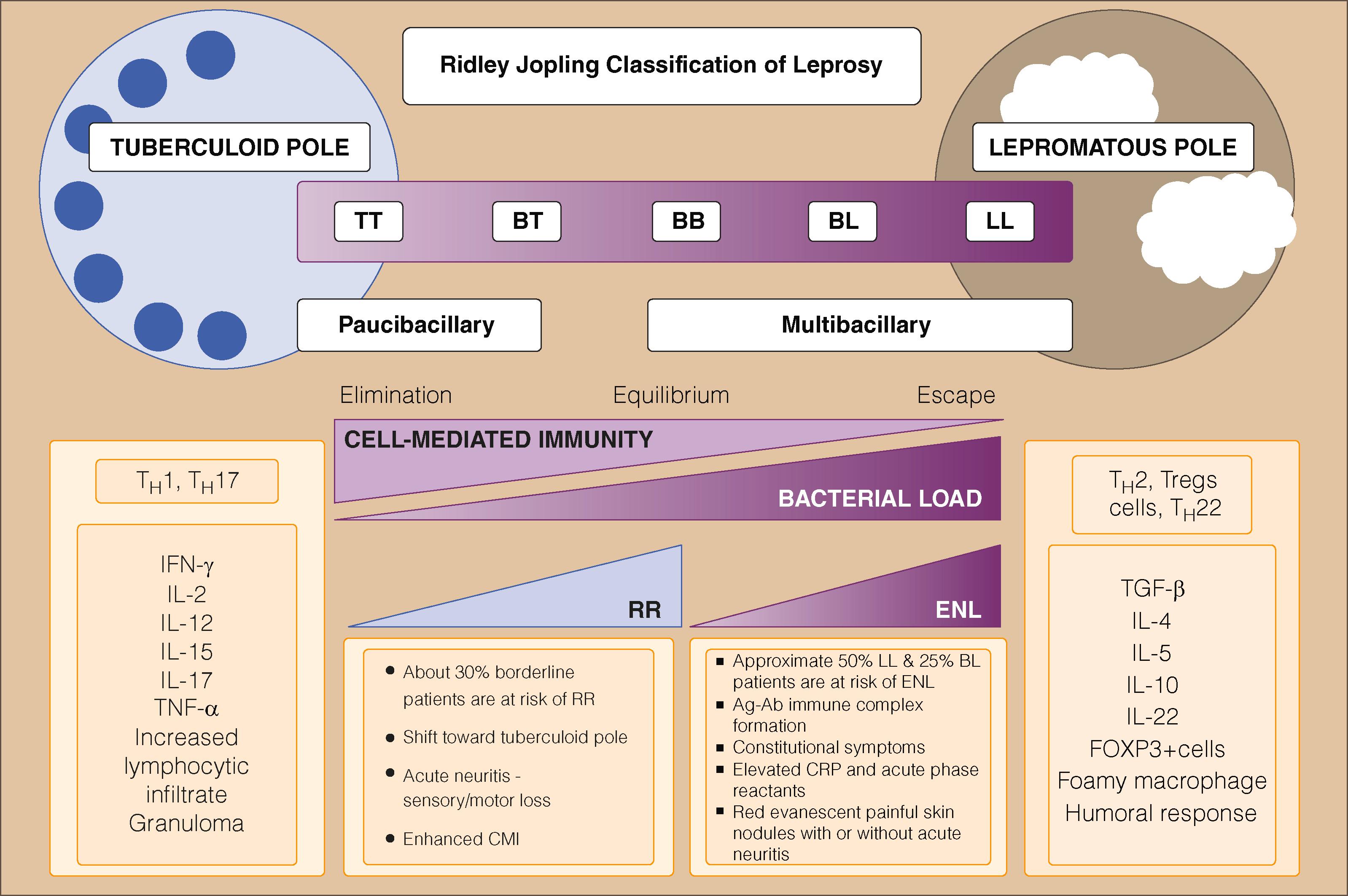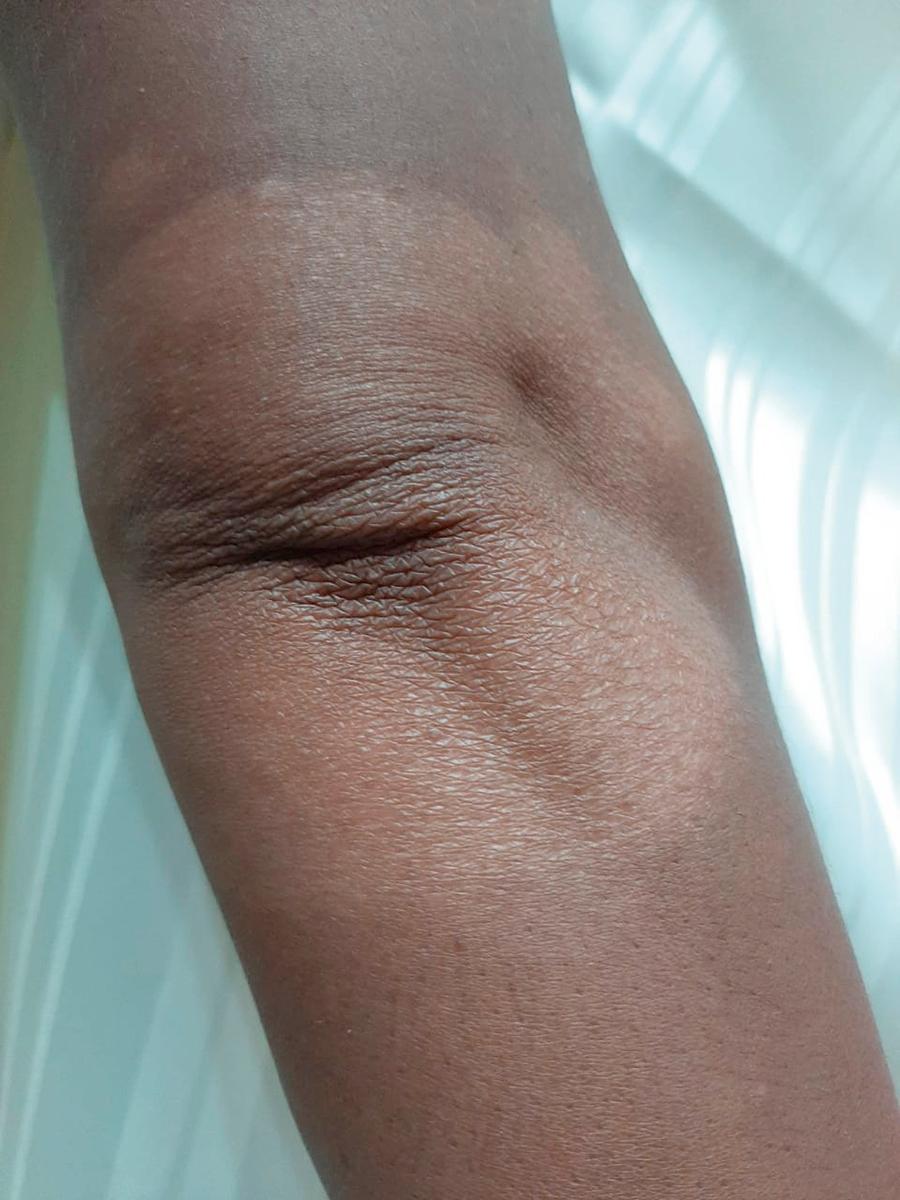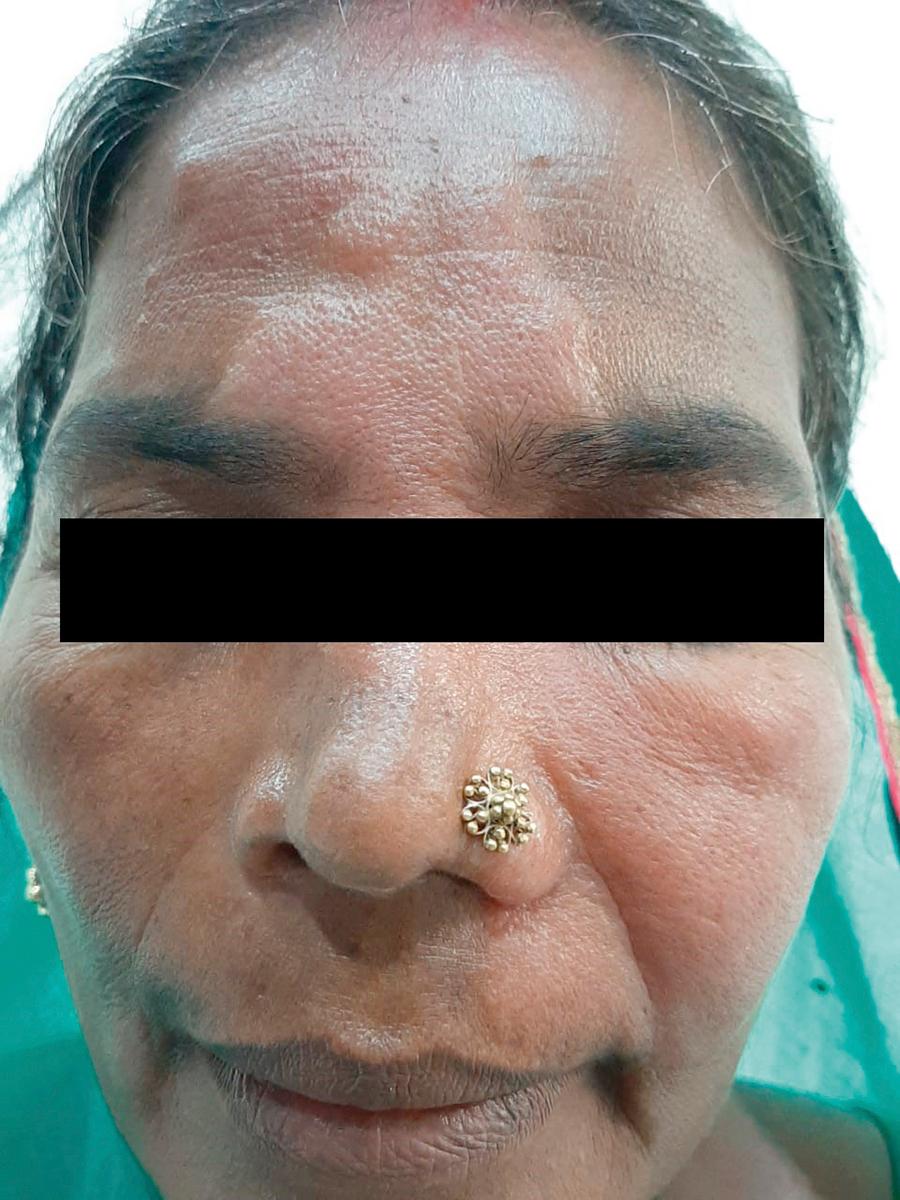Physical Address
304 North Cardinal St.
Dorchester Center, MA 02124
Leprosy (Hansen disease), which is caused by Mycobacterium leprae, is a chronic infection found worldwide but with about 75% of cases reported in India, Brazil, and Indonesia. The primary clinical manifestation is hypopigmented, hypoesthetic or anesthetic, nonpruritic skin lesions. Peripheral nerve damage, which can be a result of the immune response to the infection, leads to loss of sensation and decreased motor function. The peripheral neuropathy ( Chapter 388 ) can be complicated by painless injuries, secondary bacterial infections, and muscle atrophy and contractures. Leprosy is not a fatal disease, but the debility associated with leprosy increases the risk of death from malnutrition or other infections. Although the transmissibility of M. leprae is low and effective medications can cure it, the substantial stigma associated with it remains an ongoing challenge.
M. leprae is a nonmotile, non–spore forming, microaerophilic, acid-fast staining, slow-growing, rod-shaped bacterium measuring 1 to 8 microns in length and 0.3 microns in diameter. M. leprae contains a mycolic acid-rich cell wall and a single membrane. M. leprae, which has an average generation time of 14 days, probably evolved from the same common ancestor as M. tuberculosis , but it has approximately 2000 fewer genes and lacks the genes that are necessary for independent growth. M. leprae needs an optimum temperature of about 30° C, so it mostly involves cooler parts of the body, such as the ears, nose, and the superficial course of peripheral nerves. M. leprae cannot be cultivated in vitro in any artificial medium, but propagation of M. leprae in mouse foot pads provides a tool for assessing the viability of a preparation of bacteria and testing the drug susceptibility of clinical isolates.
Leprosy is a neglected tropical disease that has reached a crucial junction of worldwide control. The targeted goal of fewer than 10 cases per 10,000 population was achieved globally in 2000 and in India in 2005. However, leprosy still occurs in more than 120 countries, with more than 200,000 annual new cases, about 75% of which are from India, Indonesia and Brazil. During the severe acute respiratory syndrome coronavirus-2019 (SARS-CoV-19) pandemic, the case detection rate declined, and only about 130,000 cases were on treatment worldwide in 2020 for a rate of 16.6 per million population. During 2021, 140,594 new cases were reported globally for a case detection rate of about 18 per million population. The rate of detection of new cases increased by 10.2% as compared with 2020. In the U.S., leprosy is extremely uncommon, with fewer than 250 cases diagnosed annually, mostly in immigrants from India, Brazil, the Philippines, the Dominican Republic, and Mexico.
M. leprae can survive outside the human body in humid tropical environments for 7 to 10 days and in moist soil for a few weeks. Humans are thought to be the natural host for M. leprae , but it also grows in nine-banded armadillos found in the Americas. Other potential sources proposed for M. leprae are red squirrels, non-human primates (mangabey monkeys), rats, and vectors such as amoeba, ticks, mosquitoes, soil, and water. However, there is little established evidence for other potential sources of M. leprae infection other than from humans.
Individuals with multibacillary disease are the major source of human spread, although transmission also can occur from paucibacillary cases. The usual route of transmission is respiratory droplets, but the organisms also may enter via breached skin. M. leprae is not highly transmissible. Even in endemic areas, leprosy is rare except in persons who have prolonged, close contact with infected cases, , so travelers are not at substantial risk.
Because only 0.1 to 1% of the exposed population develops clinical disease and the disease spectrum varies among infected individuals, the susceptibility to infection, progression to clinical disease, and the severity of disease are mostly determined by host factors.
By genome-wide scans, susceptibility to tuberculoid leprosy has been located to chromosomal region 10p13. Susceptibility genes associated with leprosy include major histocompatibility complex (MHC) loci (HLA-A∗1102-B∗4006-Cw∗1502 haplotype and the human leukocyte antigen [HLA]-DRB1 locus). HLA-DR2 and HLA-DR3 genes, which are class II HLA/MHC genes, have been implicated in influencing the spectrum of disease a patient develops. Single nucleotide polymorphisms also have been identified in tumor necrosis factor (TNF) alpha and interleukin (IL)-10 genes. Several genes are involved in the host’s response to the M. leprae ; some may have a role in the adaptive immune response (e.g., HLA, TAP2 , VDR , PTPN22 ), whereas others may have a role in innate immunity (e.g., NRAMP1, TLR2 , MICA , TNF-α , MRC1 ). Depending on the alleles that an individual possesses, the individual may get a milder or more severe form of the disease or may be able to resist the infection entirely.
Dendritic antigen-presenting cells of the host recognize the lepra bacilli via their complement receptor and upregulate both MHC class II and CD40 ligands, thereby resulting in the production of IL-12. Subsequently, cytokines and chemokines, which are produced locally, regulate the type of infiltrate and thereby the course of cell-mediated immunity via a helper T-lymphocyte dominant response. The pathophysiology is not exactly known, but the features resemble type III hypersensitivity as demonstrated by the deposition of antigen, antibody, and complement (immune complexes) in the dermis. The helper T-lymphocyte response drives immunity to M. leprae and determines whether an individual will develop tuberculoid or lepromatous leprosy. Patients with tuberculoid leprosy have a T-helper 1 (T H 1) response that is associated with production of IL-12, TNF-α, and IFN-γ, thereby favoring a delayed-type hypersensitivity reaction. Lepromatous disease is associated with a weak T H 1-type response and a relative increase in T H 2-type cytokines. T H 1 cytokines are associated with activation of toll-like receptor-1 (TLR1) and toll-like receptor-2 (TLR2), and whereas T H 2-type cytokines are associated with inhibition. The expression of TLR1 and TLR2 is stronger on monocytes and dendritic cells in tuberculoid leprosy than in the lepromatous lesions. As a result, lesions of tuberculoid leprosy have more lymphocytes and transformed macrophages, called epithelioid cells, because of cell-mediated immunity and the paucity of bacilli. By comparison, the lymphopenic lesions in lepromatous leprosy have numerous bacilli within macrophages. During the course of chronic disease, erythema nodosum leprosum occurs mainly in patients who have lepromatous/borderline leprosy. Classic histopathologic features of active erythema nodosum leprosum lesions are increased vascularity with dilated capillaries in the upper and lower dermis, as well as intense infiltration with neutrophils and generally fragmented and granular bacilli. Reversal reaction or type 1 reactions are associated with borderline leprosy ( E-Fig. 301-1 ).

M. leprae has the unique ability to invade peripheral nerves, and its presence within a nerve fiber is a pathognomonic sign of leprosy. Leprosy neuropathy is a slowly progressive sensorimotor infective polyneuropathy. Invasion of Schwann cells and axons by M. leprae leads to demyelination and axonal degeneration. M. leprae binds to the G domain of the laminin alpha-2 chain that is expressed on the surface of the Schwann cell–axon unit, through a 21-kDa histone-like protein. The terminal trisaccharide of phenolic glycolipid 1, which is a surface-exposed M. leprae –specific antigen, helps to bind to laminin-2. Subsequently, M. leprae alter the interior milieu of the cell, thereby producing metabolic and functional changes in nerves. M. leprae prefer to localize in the cooler regions, so segments of nerve trunks that are superficial and in close contact with the skin are predominantly involved. Polyneuritis is severe during acute episodes of leprosy reactions and more so during type 1 reactions. The volume of the granuloma, its inflammatory cells, and intraneural and perineural edema cause pressure effects and axonal damage. Although polyneuritis continues to occur during the course of leprosy, these effects are accentuated during acute leprosy reactions. If untreated, this process progresses to nerve destruction, fibrosis, and irreversible nerve damage.
The neuropathic pain of leprosy can be caused by disorders of the somato-sensory nervous system, owing to infection itself, or by lepromatous reactions to the infection. Neuropathic pain, which usually is observed in patients who have completed multidrug therapy, can persist for months to years. The pain is generally considered to be a small fiber sensory neuropathy, with painful paresthesia as its most common effect.
The incubation period for leprosy is estimated to range from 2 to 20 years, with an average of 5 years, and about 95% of infected people may never develop clinical disease owing to their innate immune response. In the remaining individuals, the disease may self-resolve or it may progress to a clinical stage, which will resolve only if treated.
Leprosy commonly involves the skin and peripheral nerves, and its manifestations are determined by the polarity of the disease: paucibacillary (tuberculoid) or multibacillary (lepromatous). Patients commonly present with skin lesions, weakness or numbness of hands or feet caused by a peripheral-nerve involvement, deformities, resorption of fingers and toes, or a burn or ulcer in an anesthetic hand or foot. Some patients may present with acute nerve pain, sudden palsy, new skin lesions, a painful red eye, or a systemic febrile illness.
Leprosy-related neuropathic pain includes a wide spectrum of symptoms, including paresthesia, dysesthesia, hyperesthesia (increased sensitivity to normal painful stimuli), and allodynia (pain in response to a stimulus that is not normally painful) along the nerve and in its area of distribution. The reported prevalence of neuropathic pain in leprosy ranges from 11 to 70% in various studies. The neuropathic pain can be severely debilitating, affect a patient’s quality of life, and result in substantial psychological distress.
Leprosy also can be categorized as paucibacillary or multibacillary, based on the number of skin lesions, nerve involvement, and bacteriologic status ( Table 301-1 ). Another categorization based on clinical, bacteriologic, histologic, and immunologic features ( Table 301-2 ) classifies leprosy as tuberculoid, borderline tuberculoid, borderline borderline, borderline lepromatous, and lepromatous leprosy. In general, paucibacillary disease is equivalent to tuberculoid and borderline tuberculoid disease, whereas multibacillary is equated with borderline, borderline lepromatous, and lepromatous disease.
| CRITERIA | |
|---|---|
| Paucibacillary | 1 to 5 skin lesions, without bacilli in a skin smear and without nerve involvement |
| Multibacillary | Any one of:
|
| OBSERVATION | TUBERCULOID LEPROSY | BORDERLINE TUBERCULOID | BORDERLINE BORDERLINE | BORDERLINE LEPROMATOUS | LEPROMATOUS LEPROSY |
|---|---|---|---|---|---|
| Number of lesions | Usually single (up to 3) | Few (up to 10) | Several (10-30) | Many (>30), asymmetrical | Innumerable, symmetrical |
| Size of lesions | Variable, usually large | Variable, some are large | Variable | Usually small, but some can be large | Small |
| Surface | Very dry, scaly, lesions look turgid | Dry, scaly, lesions look bright and infiltrated | Dull/slightly shiny | Shiny | Shiny |
| Sensations in lesions | Absent | Markedly diminished | Moderately diminished | Slightly diminished | Minimally diminished, not affected |
| Hair growth in lesions | Absent | Markedly diminished | Moderately diminished | Slightly diminished | Not affected initially, but almost all body hair is lost in long-standing disease |
| AFB in lesions | Nil | Nil or scanty | Moderate in number | Many | Plenty, including globi |
| Lepromin reactivity | Strongly positive (+++) | Weakly positive (+ or ++) | Negative/ weakly positive –/+ | Negative | Negative |
| Histopathology | Granuloma consisting of lymphocytes, epithelioid and giant cells, small nerves completely effaced by caseating granuloma. AFB-negative | Granuloma consists of epithelioid cells and an admixture of macrophages and lymphocytes. Giant cells are also seen. Nerves replaced by granuloma. AFB may be positive or negative. | Granuloma consisting predominantly of epithelioid cells, macrophages and scattered lymphocytes. Nerve shows cut onion appearance. AFB+ | Granuloma around nerve, neurovascular bundle consists primarily of macrophages and isolated clumps of epithelioid cells. Nerves show concentric perineural cell infiltration. AFB ++ including small globi | Expansive and loose granuloma with plenty of macrophages loaded with AFB. Nerves are minimally involved. |
∗ All features can occur in various combinations as the disease progresses.
Tuberculoid leprosy is a less common, benign, and relatively stable form of disease. The number of skin lesions is usually one to three, seldom measuring more than 10 cm in diameter and infrequently positive on bacteriologic examination. The typical lesion is a well-defined erythematous plaque with raised and clear-cut edges sloping inward. The surface is dry, hairless, anesthetic, and usually scaly. A solitary peripheral nerve trunk may be thickened in the vicinity of a lesion. Skin lesions may appear at any site on the skin, but with a predilection for body parts not covered by clothing.
Borderline tuberculoid leprosy disease spans the spectrum between the tuberculoid and lepromatous poles. It is the most important part of the spectrum in terms of number of patients, frequency, severity of reactions, and nerve damage. Patients with borderline disease suffer most of the disabilities and deformities seen in leprosy. The skin lesions resemble those of tuberculoid leprosy, but the disease is not fully contained. Individual lesions do not show the well-defined margins, and their borders may start sloping outward and even fade imperceptibly into the normal skin. Lesions may have small extensions at one edge (pseudopodium), or satellite lesions may be seen. The number of lesions may vary from 3 to 10, with variation in size and contour. The lesions tend to be large and can even cover an entire limb. The lesions have sensory loss, dryness, and scaling, with erythema or hypopigmentation ( Fig. 301-1 ). Several peripheral nerves are likely to be enlarged in an asymmetrical pattern. Nerve damage with anesthesia or a motor deficit is often found at the time of presentation and can progress to nerve damage, paralysis, and deformity. Some untreated patients with repeated reactions deteriorate to borderline borderline or lepromatous leprosy.


Borderline borderline leprosy is an immunologically unstable, short-lived form of the disease that, if left untreated, mostly progresses towards the lepromatous form. Characteristic skin lesions are annular, with the inner edge well-demarcated (punched out) and the outer edge ill-defined and sloping towards normal skin. Clinically normal-looking skin within such plaques gives a “Swiss cheese” appearance ( Fig. 301-2 and E-Fig. 301-2 ). The face may be infiltrated with occasional nodules over the ears and chin.

Become a Clinical Tree membership for Full access and enjoy Unlimited articles
If you are a member. Log in here